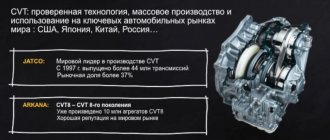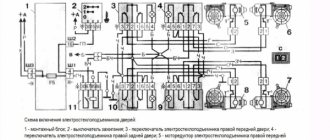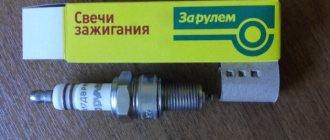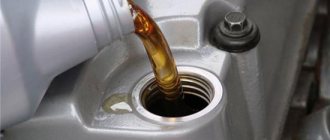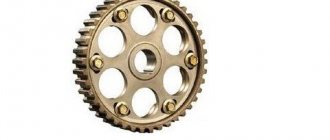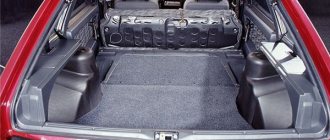Any owner will be able to fully use his car only if each of the elements of the overall mechanism works stably and without failures. Such coherence in the operation of the units will lead to the fact that all systems will be able to function extremely clearly and efficiently, thanks to which the driver will be able to enjoy control, and passengers will have the opportunity to travel comfortably. There is no point in highlighting more or less important details; the functionality of the entire mechanism depends on how harmoniously they complement each other. However, everyone knows that great importance in ensuring the owner’s ability to fully use his vehicle rests with the engine, one of the most important units of modern cars, without which not a single car can travel even a meter on its own. Despite all the abundance of companies involved in the production of engines, in this article we will together try to choose the best VAZ engine and, perhaps, after reading this material you will be pleasantly surprised by the capabilities that are included in “our” engines.
We will consider power units, which are the cause of many disputes and discussions that unfold between car enthusiasts both on the Internet - through forums, and in real life, during direct communication. So, three engines have been nominated for the title of best engine: VAZ 21116, 21126 and 21127. Which of them will be recognized as “TheBest” will be shown in our review. In fact, to understand which engine is better, you will first need to get to know them in more detail. After all, it is known that there are so many people, so many opinions, and each driver, in determining the best engine, will, first of all, be guided by personal feelings.
So which one is better?
Having familiarized ourselves with the main characteristics of our contenders, we can now safely sum up the overall results and name the winner. If you approach the question from a rational point of view, the answer to the question: “which VAZ engine is the best?” seems more than obvious - the last in the line, that is, the newest and most modified, and indeed, the VAZ 21127 engine, after all its modifications, looks like a clear favorite for the title of best, because for all its shortcomings, these are the same problems as in 21126 In case of timing belt failure and expensive maintenance, it offers very cool performance, especially for those who like to ride with the breeze. VAZ 21126 and 21127 are like brothers, however, the “twenty-seventh” is younger, but stronger, and the “twenty-sixth” is older and more confident, so to speak, that is, more significant in terms of the audience reached. Therefore, we will not even try to compare these two engines with each other, but will combine their capabilities against a common competitor - the VAZ 21116. Here we will formulate the question somewhat differently: “which engine is better, eight valve or sixteen valve?”
As an answer and, accordingly, to determine the winner, we present the following information: the main power records demonstrated by VAZ engines were achieved precisely with the help of units with 16 valves, and most importantly, when choosing a car with a 16-valve power unit, positive the owner receives more aspects than negative ones. An increase in the used volume of the fuel-air mixture, which enters the cylinders, also affects the increase in power, which is confirmed by the technical descriptions of each of the engines. In addition, changing the shape of the combustion chamber in the 16-valve engine allows it to show higher knock resistance, which is very important given the quality of the fuel that is sold at gas stations. It should also be said that in engines with 16 valves the cooling system works better, which helps to increase the reliability of the power unit. What the 8-valve unit benefits from is cheaper maintenance and, in fact, availability, since it costs less than its competitors. At one time, 8-valve power units were optimal for operation in our conditions, however, progress has made positive adjustments, allowing the engines to be modernized.
Video instructions on how to make a good VAZ engine
Motor 2101 “Kopeyka”
It’s no secret that the first “Kopeyka” is a prototype of the Italian FIAT 124.
Accordingly, the first of the VAZ engines was initially only a modification of its predecessor, a kind of tuning of the VAZ engine.
The characteristics of VAZ engines have been changed:
Further tuning of the VAZ engine consisted of strengthening the transmission, which Italian engineers liked, and later they began to use Soviet modifications on their units.
Later, exports began to spread, and for the first time a rotary engine in a VAZ appeared on cars sent to neighboring countries.
This was the first successful experiment, but due to the difficulty of repairing such a unit and the virtual lack of spare parts, over time these types of motors became unpopular. Although analysts predicted a good future for units of this type, it was only necessary to properly establish the spare parts market.
Conclusion
Therefore, to summarize and name the best VAZ engine, we give preference to the 21127 power unit, which in all respects is ahead of its competitors in this impromptu rating, but with one amendment, since its owners should be prepared for significant financial costs in the event of unexpected malfunctions . This top of the best is our subjective opinion and you may well either support it or disagree with our opinion. You can always present your arguments on this matter with reviews in the comments on the forum, share interesting photos and videos, and also offer your own options, which, in your opinion, are worthy of the title of the best VAZ engine.
Share with your friends:
Engine 1.6l 16kl
On VAZ 2114, 2113, 2115, in a limited series from the SuperAvto production, 16kl were installed. 1.6 liter engines with indexes 21124 from “Dvenashka” with a power of 89 hp. and from Priora with index 21126 with a power of 98 hp.
Engine 21124 1.6l 16kl:
- Power – 89hp
- Torque – 131 Nm at 3100 rpm. min.
- Acceleration to 100 km/h – 11.5 s.
Engine 21126 1.6l 16kl:
- Power – 98hp
- Torque – 145 Nm at 4000 (rpm).
- Acceleration to 100 km/h – 10.5 s.
These Russian modern VAZ engines will cover 300 thousand km without capital
The domestic automotive industry is not particularly diverse in creative thought, so most cars are technically the same as their predecessors from Soviet times. However, over the course of a long time, Russian VAZ engines have been undergoing many small changes, modifications and improvements. Therefore, today there are a number of power units that are characterized by unpretentiousness, reliability and durability.
The actual resource of the list below is neither more nor less - about 300 thousand kilometers (of course, subject to operation in accordance with the manufacturer’s requirements).
Engines "Gazelle", "Sobol", "UAZ" OJSC "Ulyanovsk Motor Plant" (UMZ)
One of the oldest domestic factories focused on the production of engines, founded on September 6, 1944. From a brief excursion into history: 1941 - in connection with the evacuation of part of the capacity of the Moscow Automobile Plant named after. I.V. Stalin began the rapid establishment of new production. Engines are starting to be installed on the legendary GAZ-MM lorry and three-ton trucks - ZIS-5.
Since 1969, the motor company has repurposed itself into the type of production familiar to modern car users under the UMP brand.
At this time, it is one of the largest enterprises in the Russian engineering complex for the production of power units of various modifications for trucks, passengers and multi-purpose vehicles of the GAZ and UAZ brands.
It is also worth noting that the Ulyanovsk plant is a full production cycle enterprise: from the development of automobile gasoline and gas-gasoline engines to the production and testing of finished products.
Today, the main product of the plant is a fairly diverse line of engines, in particular gasoline and gas-gasoline engines, including LPG, running on liquefied gas, and CNG, with compressed gas fuel, for light commercial vehicles GAZelle and Sobol. The main type of product is EvoTech power units of Euro-4 and Euro-5 environmental classes.
ZMZ-409
Years of production: 2001 to present
Installed on cars: UAZ 452, UAZ Hunter, UAZ Patriot
The in-line 4-cylinder 2.7-liter 16-valve gasoline engine ZMZ-409 can, without exaggeration, be called the best engine of all that are equipped with cars produced by the Ulyanovsk Automobile Plant (UAZ). Apart from low-quality dampers and timing chain tensioners, the condition of which must be regularly monitored, this engine does not have any significant shortcomings, and its service life is about 300,000 kilometers.
In conclusion, I note that in addition to Russian-made engines, some Lada cars are also equipped with engines from foreign manufacturers, the most reliable of which are considered to be Renault K4M and Nissan HR16DE engines.
More publications on the topic:
Did you like the post? Share!
Source
Run-in
Many readers are sure that the VAZ engine needs running in no more than any foreign car. And this is also one of the common misconceptions among motorists today. First, let's figure out what running in is.
Run-in is carried out for the purpose of running in the mating surfaces of parts of units, components and the machine as a whole. When mutual movement occurs between microroughnesses, contact occurs, which leads to the formation of a working surface microrelief. The result of running-in is a decrease in the magnitude of friction forces and a decrease in wear of mating parts.
Thus, it is on VAZ engines that the effect of running-in is most noticeable, while in most foreign cars, running-in does not greatly affect the characteristics of the engine and, as a result, is practically invisible to the consumer.
About the technical component
Technically, engines with 8 and 16 valves are quite different. Although all the difference is stored at the top (engine block head) where the car's camshafts (camshaft) are/are installed. In fact, this is the main design feature, but what I want to note is that almost every engine can be made into either an 8 or 16 valve version. For example, on our VAZs, the engines are very similar, and hypothetically, on the same block, you can fit a different cylinder head, with one or two camshafts.
Motor VAZ 2106
The baton of the engine, which became a real breakthrough in the Soviet market, was taken over by the VAZ 2106 engine.
It became a natural modification of the 2103 in order to increase the technical characteristics of VAZ engines in the direction of power.
The engineers achieved it:
- increasing the working volume to 1600 cm3, using the cylinder diameter, which again became 79 mm.
- The pistons for this VAZ engine were used from 21011 and it, like the donor, had two repair sizes. These VAZ engines had no other fundamental differences from the 2103, since they were equipped in the same way as their older relatives, with an “Ozone” carburetor and an ignition distributor with the same vacuum regulator.
But the 2106 engine did not find much sympathy among the owners, just as rotary engines on VAZs were once exported, since the owners of 2103, 2121, 2107 tried to select the more reliable VAZ 2103 engine.
This was due to the lower viability of the 2106 and instability of operation when using lower quality fuel. The saddest outcome was burnout of the valves and the unit required major repairs in these cases much more often than 2103.
TOP 40 most economical cars
In particular, in this article you will find: Unfortunately, only diesel models are included in the TOP 10 of the overall rating. So if you are looking for a petrol car, go straight to the cheapest petrol cars TOP 20. Renault and Peugeot were the cheapest cars.
Of the Japanese brands, only Toyota arrived. Even the “small” Nissan Micra turned out to be too voracious: it “eats” 6.5 liters per 100 km in the combined cycle.
Rating of the most economical LADA cars (gasoline consumption)
The editors of the automobile magazine "Daily Motor" analyzed the technical characteristics of modern LADA models.
Based on this data, an assessment was compiled showing which LADA cars are the cheapest (the least fuel efficient).
Remember that the cost of servicing a car consists not only of the cost of gasoline, but also of the cost of servicing. Previously, we calculated how much one kilometer would cost for the owner of a Lada car (the calculation includes: gasoline, regular maintenance and a set of tires).
Motor VAZ 21083
Before considering the characteristics of VAZ engines of a completely new principle, it is worth paying attention to such transitional units as 2108, 2110 and 2111, since it was with them that the era of fuel injection by injector and the birth of front-wheel drive began.
Both of these engines are installed on models 2108, 21083, 2109, 21099, so it is currently very popular to replace an old carburetor engine with an injection engine, due to the many advantages of the latter.
- The fundamental difference between the 21083 engine and its predecessor 2108 was that it had to be transverse in placement due to front-wheel drive. The fundamentally new piston, which used a special micro-profile, retains lubricant much better than the early 2103, which was coated with tin.
- ICE 21083 is modified with a cylinder diameter of up to 82 mm, a working volume of up to 1500 cm3, and a maximum power of 65 hp. With. increases to 68, and torque from 95 to 100.5/3400.
- The timing drive of VAZ engines of the 8th family becomes belt driven, unlike the 2103, where there was still a chain. The quality of this change is certainly debatable, but every car enthusiast finds positive and negative sides in any type of timing drive.
- New features in the VAZ 2108 and 21083 engines include a new carburetor, which becomes much more economical than its predecessor, a completely different oil pump, driven by the crankshaft; a gasoline pump with outlet and inlet pipes on the same line, as well as a structurally different water pump.
pros
- “The simpler, the better” is a popular proverb. This also applies to the 8-valve engine, a time-tested design that has only one camshaft, two valves per cylinder. There are few mechanical parts, and therefore repair and maintenance of this is much cheaper.
- Also, such a structure almost never has hydraulic compensators, which further simplifies its design. There are mechanical pushers here, which is both good and bad. Well - this mechanism is much simpler, so replacing or repairing it is also easy and cheap. By the way, these types are often equipped with stickless pistons.
- Not very picky about oil, you can fill it with semi-synthetic oils.
- It is undemanding to the quality of fuel (of course, within reason), you can safely pour 92 gasoline and not be afraid.
- Size. The upper part is much smaller, because there is only one shaft. Easier to reach attachments, generator, starter, etc.
Motor VAZ 2103
Since the late 70s, cars produced on special order, for example, for some police units, have had a completely new power unit, which has different technical characteristics, unlike other VAZ engines.
It was installed both on the later Kopeykas and on its successors - export 2102, 2103, 2107 and later on 2121, 21053.
These VAZ 2103 engines have become an absolute novelty (plural, but before and after everything is singular). Thanks to its dynamics, they allowed it to accelerate to 100 km/h in less than 17 seconds.
Such indicators became possible due to a number of changes:
- The volume increased to 1500 cm3;
- The piston stroke increased by 14 mm;
- maximum power became 77 hp. With. ;
- torque was determined for the first time. On this type of VAZ engine it became 104/3400.
The cylinder block is made of a special cast iron alloy, the cylinder head is made of aluminum. These rules were mandatory for all types of engines, and the fundamental difference was in the diameter of the cylinders. If for units 21011, 2105 and 2106 it was within 79 mm, then in 2103 it became 76 mm.
Another positive feature of this model is the ability to install crankshaft 21213, which has identical parameters, but improved technical characteristics of the VAZ engine.
In addition, the 2103 can be equipped with both classic and contactless ignition. Rebuilding the engine was not particularly difficult for specialists, and the availability of spare parts in terms of availability and pricing did not force the owner to search for places and means of purchase for a long time.
Valve clearance adjustment interval
Some readers in the discussion of the article cited the Kia Rio and Hyundai Solaris as examples, arguing that they require valve adjustment every 30 thousand kilometers. Like, more often than with a VAZ engine. This is also not entirely true: the manual of Korean bestsellers says that a check is required once every 90,000 km. Usually it shows that you can drive up to 150,000 km. But VAZ eight-valve engines need adjustment much more often. According to the regulations - once every 45,000 km. And the experience of operating editorial cars confirms these figures. This procedure can be done less frequently only using high-quality oils and subject to regular replacement every 7,500 km.
Oil consumption
Many readers are convinced that increased oil consumption in the first thousand kilometers is nothing more than a myth. True, often such judgments are based only on personal experience, which is limited to the operation of one or, at best, several cars. Hundreds of cars, usually fresh off the assembly line, passed through the editorial office of the magazine “Behind the Wheel.” As a result, ZR experts have accumulated enormous experience in terms of operation. We have something to compare with. So, oil consumption for engines produced by VAZ, as a rule, begins to increase noticeably at 100,000 km. The reason may be oil consumption due to waste, or leaks of various engine seals. For comparison: the mileage of the editorial Lada Largus with the Renault K4M engine is already 125,000 km, and no drop in the oil level on the dipstick is observed at all.

